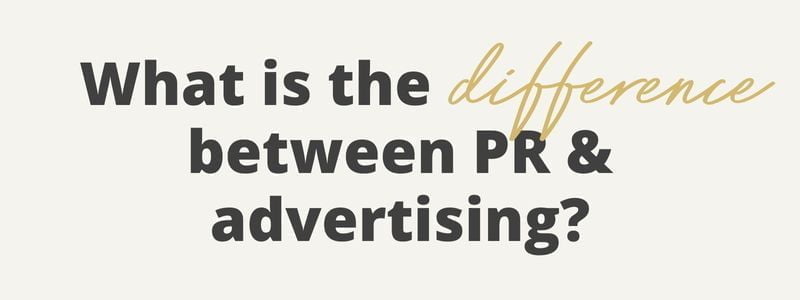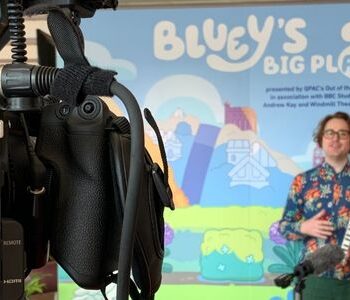What’s the difference between PR and Advertising?
PR and advertising are similar in that they share the same goal to promote a business, a brand, or a product – but they are distinctly different.
Both cultivate relationships with your target audience and the wider community to boost sales and brand awareness. And both do this while maintaining your business’ trust and reputation.
However, PR and advertising have completely different ways of achieving these important communication goals.

What is PR?
PR (Public Relations) is unpaid media coverage earned through strategic publicity activities, events, and communications with journalists, media outlets, and social media influencers. Businesses, organisations, and individuals use PR to boost brand awareness and build a positive reputation with their stakeholders, shareholders and the community.
PR agencies provide a number of services including proactive public relations activity, crisis management, media training, corporate communications, media relations, and social media management, as well as speech and content writing.
The focus of PR is to increase brand awareness.
What is Advertising?
Advertising is paid media used to promote or sell a product. It’s often based around persuading customers, old and new, as to why they should buy a particular product or service from a specific brand or business.
Paying for an advertisement boosts brand awareness while maintaining a positive brand image with your target audience as well as the wider community.
The focus of Advertising is to boost sales.
PR v Advertising
Is one better than the other?
Does paid media coverage yield better ROI (Return On Investment) than unpaid media coverage?
Can the two work together?
It’s important to consider the below.
– Trust and credibility
Trust and credibility are vital for any business, organisation, or individual. With PR being largely focused on earned media, you are more likely to gain trust and credibility by achieving coverage for your brand or product through news and media outlets. Third-party endorsements from traditional media outlets such as newspapers, TV, radio, and online publications ooze credibility. Your audience is more likely to respond to this type of media coverage as it is impartial and reliable. In this way, PR can be more powerful as it helps to shape public opinion.
Nowadays, audiences are more aware and distrustful of advertising tactics, making it harder to earn trust and credibility from advertising alone. There’s a big difference between a brand telling you they’re great versus a third-party source saying the brand is great.
– Cost
Cost is also a key difference and could possibly be the most important factor in determining whether you decide to use PR or advertising.
In advertising, what you pay for is what you get. When your allocated budget runs out, your advertising stops. However, there are some benefits to this. When creating your advertisement, you have control over your messaging as well as where and when it will be seen in the media.
With PR, you have less control over your media coverage as ultimately, it’s up to the journalists how they write your story. It’s important to note as well that PR never comes with a guarantee the story will run – it’s up to the PR experts to pitch and craft your story in a way that resonates with journalists. Generally though, PR is much more cost efficient than advertising, and there’s more “bang for buck” if you consider the credibility your brand gains from media coverage.
– Longevity
With advertising, the amount you pay determines how long your message is circulated and its reach. Due to the nature of the news cycle and journalists jumping quickly from one story to the next, your story is more likely to stay active for longer through advertising, providing you have the funds.
PR also has a focus on gaining as much media coverage as possible and audience reach is not limited to a niche market dependent on your budget. A successful story can see you reaching millions for a fraction of any advertising budget. You can also pitch your story to a number of journalists across a number of different mediums allowing your story to be published in a variety of ways.
– Proactive Vs Reactive: Versatility
Another key difference between advertising and PR is what they can be used for. While advertising can be great for promoting a new product or event, it’s difficult and costly to use in a responsive manner. If your company has done something they’re proud of (for example, donating a large sum to charity) and they want the community to know, advertising may appear boastful and self-serving.
PR is far more versatile, especially when responding to a crisis or trying to navigate any negative press coverage about their client. Media releases, interviews, and press conferences can be arranged quickly when there’s breaking news, allowing businesses to be part of the narrative to try and reduce the damage to their brand’s reputation. Media training can also be utilised in a tight timeframe to help boost the confidence of key spokespeople and keep key messaging on track.
Using PR and Advertising
For some campaigns though, using PR and advertising together can be a great way to gain maximum possible exposure for your business or your organisation. Cost is a major factor but if you can afford it, running them in tandem means you can leverage the advantages of both to meet the objectives and outcomes you’re wanting to achieve.
Adoni Media has won and been nominated for a number of awards for successfully running a number of multi-platform campaigns. If you would like to work with a PR agency that has proven results, contact us.


